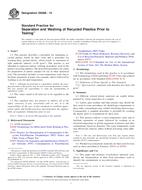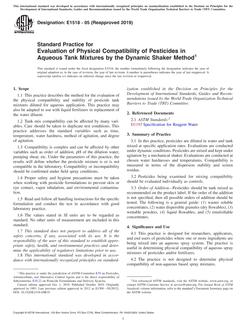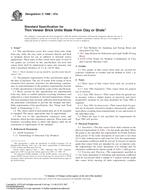1.1 This guide covers information pertaining to a broad spectrum of practices and applications of soil atmosphere sampling, including sample recovery and handling, sample analysis, data interpretation, and data reporting. This guide can increase the awareness of soil gas monitoring practitioners concerning important aspects of the behavior of the soil-water-gas-contaminant system in which this monitoring is performed, as well as inform them of the variety of available techniques of each aspect of the practice. Appropriate applications of soil gas monitoring are identified, as are the purposes of the various applications. Emphasis is placed on soil gas contaminant determinations in certain application examples.
1.2 This guide suggests a variety of approaches useful to successfully monitor vadose zone contaminants with instructions that offer direction to those who generate and use soil gas data.
1.3 This guide does not recommend a standard practice to follow in all cases nor does it recommend definite courses of action. The success of any one soil gas monitoring methodology is strongly dependent upon the environment in which it is applied.
1.4 Concerns of practitioner liability or protection from or release from such liability, or both, are not addressed by this guide.
1.5 This guide is organized into the following sections and subsections that address specific segments of the practice of monitoring soil gas:
| Section | |
| 4 | Summary of Practice |
| 4.1 | Basic principles, including partitioning theory, migration and emplacement processes, and contaminant degradation |
| 4.7 | Summary Procedure |
| 5 | Significance and Use |
| 6 | Approach and Procedure |
| 6.1 | Sampling Methodology |
| 6.5 | Sample Handling and Transport |
| 6.6 | Analysis of Soil Gas Samples |
| 6.7 | Data Interpretation |
| 7 | Reporting |
1.6 This guide does not purport to set standard levels of acceptable risk. Use of this guide for purposes of risk assessment is wholly the responsibility of the user
1.7 The values stated in either inch-pound or SI units are to be regarded separately as the standard. The values given in parentheses are for information only.
1.8 This standard does not purport to address all of the safety problems, if any, associated with its use. It is the responsibility of the user of this standard to establish appropriate safety and health practices and determine the applicability of regulatory limitations prior to use.
1.9 This guide offers an organized collection of information or a series of options and does not recommend a specific course of action. This document cannot replace education or experience and should be used in conjunction with professional judgment. Not all aspects of this guide may be applicable in all circumstances. This ASTM standard is not intended to represent or replace the standard of care by which the adequacy of a given professional service must be judged, nor should this document be applied without consideration of a project’s many unique aspects. The word “Standard” in the title of this document means only that the document has been approved through the ASTM consensus process.
Product Details
- Published:
- 11/15/1992
- Number of Pages:
- 36
- File Size:
- 1 file , 260 KB


